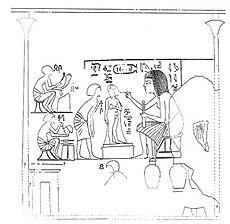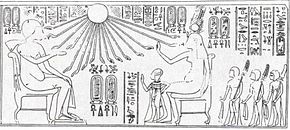Baketaton
| Baketaton in hieroglyphics | |||||||
|---|---|---|---|---|---|---|---|
Beketaten (Baket Aton) B3k.t JTN servant of Aten |
|||||||
| Tomb of Huja in Achet-Aton, making a statue of Baketaton | |||||||
Baketaton , also Baket-Aton or Beketaton , was an ancient Egyptian princess of the 18th Dynasty ( New Kingdom ). Apart from the inscriptions and illustrations in Achet-Aton , today's Tell el-Amarna, nothing is known about the life or later whereabouts of this king's daughter.
Family and title
The origin of Baketaton is unknown as it is not mentioned in inscriptions. She is known as Sat-nisut ("daughter of the king"). Their classification in the time and family around Amenhotep III can be assured . and Amenophis IV. ( Akhenaten ) are valid, as the few documents that exist about them so far come exclusively from Akhenaten's former capital Akhet-Aton. There are no known representations that explicitly name a father or mother of this king's daughter in the inscriptions, which is why the assumptions about her parents are assumptions.
Baketaton bears the title of "King's Daughter". Inscriptions in the grave of the asset manager and head of the harem of the great royal wife Teje , Huja , in Achet-Aton refer to her several times as the "daughter of the king, of his body, whom he loves, Baketaton". The king's name is not mentioned. There is no reference to the mother, as is the case, for example, with the inscriptions on all six daughters of Akhenaten and Nefertiti: “Daughter of the king, from his womb whom he loves, born of the great royal wife Nefer-Neferu-Aton- Nefertiti ". Since both Teje and Baketaton as well as Nefertiti and some daughters are depicted in the representations in the tomb and can be identified by the inscriptions, it can be ruled out that Baketaton was a daughter of Nefertiti and Akhenaten.
Representations
The images of Baketaton and the inscriptions that name them are always closely connected to the depiction of the Great Royal Wife Teje , whose name is written in a cartouche in these reliefs, like that of Nefertiti . In one scene, Baketaton and Teje are played by Amenophis III. welcomed and both raise a hand as a sign of respect. This representation of Amenhotep III. in Achet-Aton was, among other things, the reason for accepting a correspondence between father and son. On the other hand, it was seen as a posthumous tribute to the late king by his wife and daughter. The other side of the relief shows Akhenaten, Nefertiti and four daughters of the royal couple: Meritaton , Maketaton , Anchesenpaaton and Neferneferuaton tascherit . Baketaton can be seen in two more scenes in the grave: In one, Auta (Iuti), the supervisor of the sculptors of Queen Teje, makes a statuette of her, in another the king's daughter enters a temple with Akhenaten and Teje.
Conclusions and Issues

Origin and age
Baketaton wears the so-called youth lock on the illustrations , also known as side lock or side braid, which can indicate a small child or a young girl. The symbolic content within ancient Egyptian art can vary here, so that small children are depicted older than they actually were or otherwise younger. Baketaton's portrayal speaks for a four to five year old child, but according to Joyce Tyldesley this cannot be the case if she is another daughter of Amenhotep III. and Teje was. In this case, she must have been significantly older. According to Howard Carter , Baketaton was the youngest child of Amenhotep III. and Queen Teje. In his opinion, Baketaton was roughly the same age as Anchesenpaaton, the third oldest daughter of Akhenaten and Nefertiti, who was born around the fifth and sixth year of Akhenaten's reign, respectively.
In his documentation on the rock tombs of Amarna, Norman de Garis Davies goes into volume III on all representations in the tomb of Huja. Regarding the scene of Amenhotep III, Teje and Baketaton, he notes: "The description of Baketaton, the king's daughter, of the body he loves is here for the first time in the presence of her royal father."
In Theodore M. Davis' 1910 publication The tomb of Queen Tîyi. The discovery of the tomb of the tomb KV55 discovered in 1907 in the Valley of the Kings , an abstract by Gaston Maspero deals with the life of Queen Teje, since Davis saw this tomb as hers. At Baketaton, Maspero notes that nothing was known at the time except the name of the princess. Since it is called only in Akhetaton and the inscriptions no identification of the parents is possible, its name also the god Aton includes, it was assumed she was a daughter of Akhenaten. Maspero stated that there was evidence that Baketaton was a late-born daughter of Teje and Amenhotep III. and its original name could probably have been Baket amun , which was eventually changed to Baket aton during the reign of Akhenaten . He believes Baketaton was very young when her father passed away, as Akhenaten depicted her as a little girl in the 12th year of Akhenaten's reign. Because of their only documented mention in Achet-Aton, Baketaton must have been in the late reign of Amenhotep III. have been born.
The most obvious conclusion of these representations is therefore that Baketaton was a daughter of Amenhotep III. and to see Teje. This thesis is represented by the Egyptologists Howard Carter, Cyril Aldred and Christiane Desroches Noblecourt as well as Dorothea Arnold . Baketaton would be next to Sitamun , Isis , Henuttaunebu and Nebet-tah the fifth daughter of the royal couple.
Marc Gabolde, however, sees Baketaton as a daughter of Akhenaten and his great lover Kija . The relationship between Teje and Baketaton was therefore more that of a queen and her granddaughter.
Nicholas Reeves assumed, among other things, that Baketaton had a daughter of Amenhotep III. and whose daughter Sitamun could have been.
Surname
At times it is also believed that Baket aton was a newly adopted name and that it was originally called Baket amun . Gaston Maspero has already said this and Erik Hornung is also in favor. One of Nicholas Reeves' theses on Baketamun is the renaming of the Princess Sitamun in Baketaton, who had adopted a name adapted for this time in the Amarna period . Joyce Tyldesley names in this context Princess Nebet-tah, another daughter of Amenhotep III. and Teje. However, this king's daughter is rarely depicted.
Nothing is known about her life or death and after Tey's death in Akhenaten's 14th year of reign she is no longer mentioned in any inscription. Baketaton's grave site is also unknown.
literature
- Christiane Desroches-Noblecourt : Life and Death of a Pharaoh. Tut-ench-Amun. Ullstein, Berlin et al. 1963.
- Aidan Dodson , Dyan Hilton: The Complete Royal Families of Ancient Egypt. Thames & Hudson, London 2004, ISBN 0-500-05128-3 , p. 154.
- Joann Fletcher : Diary of a Pharaoh. Amenhotep III Weltbild, Augsburg 2001, ISBN 3-8289-0778-4 .
- Nicholas Reeves: Akhenaten. Egypt's false prophet (= cultural history of the ancient world . Vol. 91). von Zabern, Mainz 2002, ISBN 3-8053-2828-1 .
- Joyce Tyldesley : The Queens of Ancient Egypt. From the early dynasties to the death of Cleopatra. Koehler & Amelang, Leipzig 2008, ISBN 978-3-7338-0358-2 , p. 120.
Individual evidence
- ↑ Norman de Garis Davies : The Rock Cut Tombs of El Amarna. Parts III & IV - The Tombs of Huya and Ahmes. The Egypt Exploration society, London 2004, ISBN 0-85698-160-5 , tables IV and VI.
- ↑ Norman de Garis Davies: The Rock Cut Tombs of El Amarna. Parts III & IV - The Tombs of Huya and Ahmes. London 2004, p. 16.
- ↑ Norman de Garis Davies: The Rock Cut Tombs of El Amarna. Parts III & IV - The Tombs of Huya and Ahmes. P. 14 and panel XVIII.
- ↑ Joyce Tyldesley: The Queens of Ancient Egypt. From the early dynasties to the death of Cleopatra. Leipzig 2008, p. 120.
- ↑ Howard Carter : Tut-ench-Amun. An Egyptian royal tomb. Volume 3, FA Brockhaus, Leipzig 1934, p. 20.
- ↑ Norman de Garis Davies: The Rock Cut Tombs of El Amarna. Parts III & IV - The Tombs of Huya and Ahmes. London 2004, p. 15.
- ^ Theodore M. Davis, Gaston Maspero, Grafton Elliot Smith et al .: Theodore M. Davis' excavations: Bibân el Molûk. The tomb of Queen Tîyi. The discovery of the tomb. London 1910, p. 19.
- ^ Dorothea Arnold : The Royal Women of Amarna. Images of Beauty from Ancient Egypt. Metropolitan Museum of Art, New York NY 1996, ISBN 978-0-8109-6504-1 , p. 10.
- ^ Aidan Dodson, Dyan Hilton: The Complete Royal Families of Ancient Egypt. London 2004, p. 154.
- ↑ Howard Carter: Tut-ench-Amun. An Egyptian royal tomb. Volume 3, FA Brockhaus, Leipzig 1934, p. 20.
- ^ Cyril Aldred : Akhenaten. God and Pharaoh of Egypt. Weltbild, Augsburg 1990, ISBN 3-89350-079-0 , p. 109 and illustration 52-53.
- ^ Christiane Desroches-Noblecourt: Tut-ench-Amun. Berlin et al. 1963, pp. 154-155.
- ^ Dorothea Arnold : The Royal Women of Amarna. Images of Beauty from Ancient Egypt. Metropolitan Museum of Art, New York NY 1996, ISBN 978-0-8109-6504-1 , p. 10.
- ↑ Marc Gabolde: Baketaton fille de Kiya? In: Bulletin de la Société d'Égyptologie de Genève. Vol. 16, 1992, ISSN 0255-6286 , pp. 27-40.
- ↑ Marc Gabolde, In: Alfred Grimm, Sylvia Schoske (ed.): The secret of the golden coffin. Akhenaten and the end of the Amarna period (= writings from the Egyptian collection. Vol. 10). (Published on the occasion of the special exhibition The Secret of the Golden Coffin, Munich, State Museum of Egyptian Art, October 17, 2001 to January 6, 2002). State Museum of Egyptian Art, Munich 2001, ISBN 3-87490-722-8 , p. 21.
- ↑ Nicholas Reeves: Akhenaten. Egypt's false prophet. Mainz 2002, p. 70.
- ^ Theodore M. Davis, Gaston Maspero, Grafton Elliot Smith et al .: Theodore M. Davis' excavations: Bibân el Molûk. The tomb of Queen Tîyi. The discovery of the tomb. London 1910, p. 19.
- ↑ Erik Hornung: Akhenaten. The religion of light. Patmos, Düsseldorf 2003, ISBN 3-491-69076-5 , p. 125.
- ↑ Nicholas Reeves: Akhenaten. Egypt's false prophet. Mainz 2002, p. 70.
- ↑ Joyce Tyldesley: The Queens of Ancient Egypt. From the early dynasties to the death of Cleopatra. Leipzig 2008, p. 120.
| personal data | |
|---|---|
| SURNAME | Baketaton |
| BRIEF DESCRIPTION | egyptian princess of the 18th dynasty |
| DATE OF BIRTH | 14th century BC Chr. |
| DATE OF DEATH | 14th century BC Chr. |


